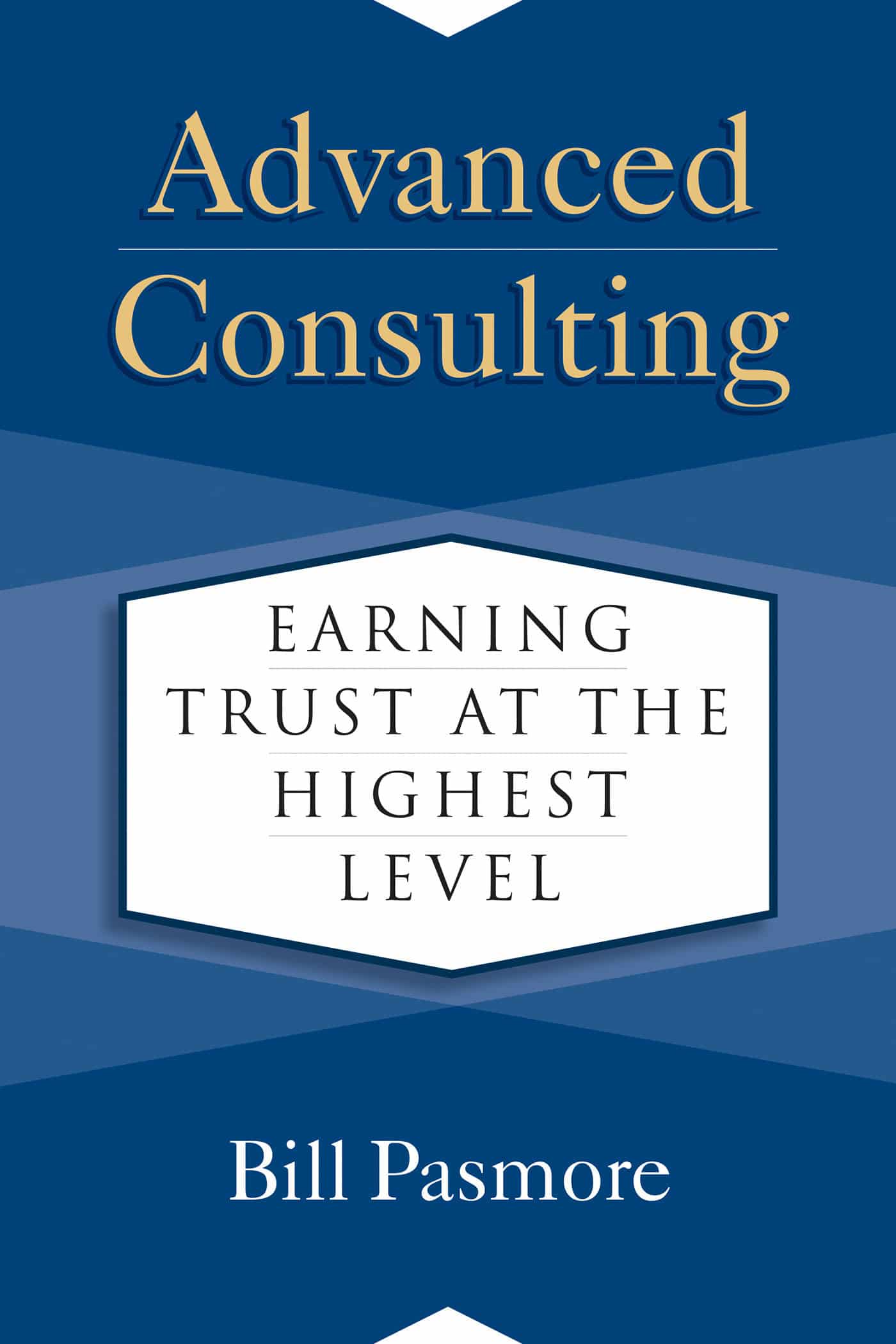Advanced Consulting: Earning Trust at the Highest Level
26.00 JOD
Please allow 2 – 5 weeks for delivery of this item
Description
This is the first book to address the specific needs and challenges faced by high-level consultants, who work on very complex projects and must win the confidence of the most senior leaders in organizations.Advanced consulting requires both expertise and personal qualifications that are distinct from those needed in everyday consulting. Advanced consultants work with high-level executive teams on complex issues such as strategy, organizational design, merger integration, digital disruption, culture change, and system-wide transformation. While neophyte consultants are often given a playbook to follow, advanced consultants need to invent methods that take full advantage of the opportunities that their work with clients presents. There is an art to advanced consulting as well as a science; who you are is as important as what you do. Bill Pasmore draws on his four decades of experience as a consultant and teacher of consultants to show readers how to see possibilities that are not evident, conduct analyses that support the value of more comprehensive work, build relationships that engender deeper trust, adapt to changing circumstances, and empower members of their team to take independent actions while maintaining overall control of an engagement. Illustrated with vivid real-world examples and including a self-assessment to measure your progress, this book equips you to advance to more senior positions in your firm or to build a successful independent practice.
Additional information
| Weight | 0.6 kg |
|---|---|
| Dimensions | 2.3 × 16.4 × 23.7 cm |
| PubliCanadation City/Country | USA |
| by | |
| format | |
| Language | |
| Pages | 240 |
| publisher | |
| Year Published | 2020-3-20 |
| Imprint | |
| ISBN 10 | 1523088060 |
| About The Author | Bill Pasmore is professor of practice at Columbia University's Teachers College as well as senior vice president of organizational leadership at the Center for Creative Leadership. He heads his own consulting firm, Pasmore Advisors, and was previously partner at Oliver Wyman Delta consulting. He holds a doctorate from Case Western Reserve University, where he was also a tenured full professor. He is the author of eight books. |
“Having worked with Bill for quite some time, I can attest that he knows what he writes.” —Vinita Gupta, CEO, Lupin “If you’ve ever wondered what it takes to consult at the highest levels of an organization, this book will help you peek behind the curtain and see that there is indeed a method that underlies the magic. Based on Bill Pasmore’s own journey from academia to advanced consulting, this book provides a firsthand account of what it takes to truly win the trust of senior executives—and take your career to the next level of impact.” —Ron Ashkenas, Emeritus Partner, Schaffer Consulting, and coauthor of the Harvard Business Review Leader’s Handbook “Dr. Pasmore has helped numerous CEOs successfully transform their organizations and has also defined the field of organizational leadership. All his work shares an overarching theme—the attention to both the ways to get things done and the people in the organization and in his own team. This book is a must-read not only for senior consultants but also for any change agents who want to influence their organizations.” —Dr. Harvey Chen, Chairman of the Board of Advisors, Center for Creative Leadership, Greater China “Advanced Consulting focuses on working with C-suite clients, but it is much more than that. It is the best book I have read on consulting since Block’s Flawless Consulting, covering a wide range of topics from business to psychology. Each chapter provides simple, but not oversimplified, models that any consultant will find useful.” —Gervase R. Bushe, Professor of Leadership and Organization Development, Beedie School of Business, Simon Fraser University; author of Clear Leadership and The Dynamics of Generative Change; and co-editor of Dialogic Organization Development “Having been a senior consultant and now on the client side, it’s clear to me how valuable it would be for consultants who wish to hone their craft and become senior partners to read this book. It’s a shortcut to gaining vital knowledge that would require years of experience to obtain.” —Juan Carlos Rivero, Chief Talent Officer, Marsh & McLennan Companies |
|
| Excerpt From Book | PROLOGUEIt’s 1998. I’ve gone to work for Delta Consulting, a New York–based consulting firm started twenty-five years previously by David Nadler, a former Columbia Business School professor. The firm specializes in consulting to CEOs. Even though I have been consulting for over twenty years, I have recently completed six full weeks of orientation to learn to do consulting the way people do at Delta consulting. This is a description of a fairly typical first meeting between Delta and a client, in which I had the opportunity to observe David Nadler (a wonderful mentor and friend to me, now deceased) work his art. The names of the firm and client have been changed but the rest is as it happened that day. 8 a.m.— t h e h e l ip ort at 12 t h a n d 30t h on t h e H u dson. As the Sikorsky A-76 descends over the water, the calm water of the river at first erupts into a fury of waves and spray, and then actually seems to form a depression as it absorbs the weight of the powerful craft that hovers above it. A second later, as the helicopter settles on the tarmac, the river returns to normal, no worse for wear.John Healey, the corporate pilot who guides the helicopter with thetail number PM101 that identifies the aircraft to air traffic controllers on its frequent journeys between Hartford and New York, explains that he earned his pilot’s license before his driver’s license, by work- ing for flying time instead of pay at the local airport. After that, it was the military, where he learned to fly these strange birds without wings. Since then, he’s never paid a cent to fly. As a pilot who still has to pay to rent an airplane, I envy him.“Are you Dr. Nadler?” he asks. “No, I’m Bill Pasmore,” I tell him. He doesn’t seem impressed; to John, I might as well have been an- other piece of baggage. “Well, is Dr. Nadler joining us this morning?” “Yes, he’ll be along shortly.” On cue, David arrives, and soon we are lifting off over the Hudson, straight up past the 38th floor of 1177 6th Avenue, where our office is located. Hartford is 48 minutes upstream.The reason for this magic carpet ride needs some explanation. This story, like others, has a beginning. It seems that this fellow named George Smith runs a company located in upstate New York that keeps the local Wegman’s grocery in business and, by the way, Delta Consulting, too. George, who has worked closely with David for many years, experienced an interesting transition a few years earlier, becoming the first non-family member to run the company. The last family member who served as CEO before George was another client of David’s and took David’s advice about how to retire with style and grace. As a result, the company didn’t miss a beat as the reins were handed over to George. There were other CEOs in the news at the time who could have used David’s help with succession planning but failed to ask for it. Some of them didn’t fare as well. Succession can be wonderful, or it can be hell.George finds time to sit on the board of People’s Mutual, one of the largest mutual life insurance companies, which in 1998 had about$60 billion in assets and another $130 billion under management. The company is large enough to own several other companies that would be large in their own right—such as the Stratus Fund, which offers People’s Mutual the opportunity to get into the 401K asset manage- ment business; John Cline & Company, which serves individual and institutional investors; Malther Realties, which manages real estate equities; Pinetree Capital Management, which provides investment advisory services to the insurance industry; and Nova Leveraged Cap- ital Corporation, a commercial finance company. People’s Mutual also owns PM101. They can afford it.Sam Tyler has been CEO of People’s Mutual for nine years. Under his uncannily insightful leadership, the company has done well, doubling in size while making bold moves into new products that its largest competitors still haven’t matched. There is no doubt that Sam deserves to go out a hero and that is precisely what he would like to do. He’s not having as much fun as he used to; some of his close friends have died; others are playing golf and reaping the just rewards of a life of hard work and honest living. Sam is about as down to Earth, honest in his self-appraisal, and open in his confusion about how to do this thing right as anyone you will meet. He started out as an insurance agent (he must have been a good one) and rose through the ranks. Now, at age sixty-one, he’s decided that he doesn’t need to ride the horse until sixty-five or beyond. In fact, he’d like to hang up the spurs at sixty-three. He mentioned this to the board, and George picked up on his inner turmoil. There’s a problem, you see; Sam has no clear heir apparent. He feels as though he has failed to prepare someone properly but, at the same time—like a guy shopping for a new car—he has made up his mind to make a trade and he wants to close the deal. Now.George pulls Sam aside after the board meeting and mentions that he’s had a little experience with succession himself, from the other side. No, he doesn’t have the answers for Sam, but he knows someone he thinks could help. George calls David to ask a favor. Then Sam calls David. Then David calls me. We’ll meet at the helipad early next Wednesday morning. In the meantime, I read the background that our research group has prepared on the company and the materials Sam sent along.Have I ever consulted in the insurance industry before? No. That’s OK. David knows the lingo, and I’ll pick it up along the way. Have I ever done a CEO succession project? No. That’s OK. David knows the process. I’ll pick it up along the way. Why am I here? Precisely because this is what I need to learn. There are certainly others more qualified, more experienced in this particular work and industry. David has an eye on the future; the sooner he gets me up to speed, the better it is for my billings—and the firm’s. I don’t mind tagging along.Incidentally, David is looking forward to this. It’s a “try to stump the band” challenge for him. It’s one thing to work with the same clients, year after year. You get to know them and they get to know you. If you have done good work, they appreciate having you around. You’re allowed to offer your advice and they’re allowed not to take it every time you give it—you’re friends and will continue to be. The work won’t disappear tomorrow with one misstep.This situation is different. Each CEO is different. Prior to the first meeting, we don’t know what Sam is like. He mentions a few things over the phone, agrees to fly us up in the helicopter, and meet with us for three hours to see if there is any point in talking further. David finds the challenge of not knowing what Sam will ask and what an- swers he will give invigorating. It’s a make-or-break encounter. Any- thing could happen. Sam might not like the way we look. He might be the type of guy who needs advice, wants advice, but can’t bring himself to take it. It could be that he hates consultants and is only see- ing us to humor one of his board members. We might say something or do something that turns him off. If he doesn’t like us, there are a lot of other consultants in the world. So we’re going to be on trial. Suddenly, I feel like one of the mannequins in the window of Saks Fifth Avenue. On display with nothing to say. In reality, I know that the spotlight isn’t on me. David is the lead on this one. Somehow, I have confidence that Sam won’t stump the band. I’ll contribute what I can, focus on developing a good relationship with Sam, and try to learn as much as possible about his business and ours.David has the foresight and confidence to anticipate that things could go well. He tells Sam before the visit that he will be bringing along a colleague because he really doesn’t have time to work on another long-term engagement. Sam probably figures that this is a gimmick that all consulting firms use to double their billings. Never- theless, he consents. After all, he’s anxious to buy that car. Now. The helicopter seats six. Bring the whole gang.After pointing out landmarks and offering last-minute advice (let me take the lead, but don’t be afraid to jump in) David spots the company from the air. It looks like a college campus. We touch down at the helipad, which is just at the back of the employee parking lot. We are immediately met by a stretch limo that takes us the two blocks to the front door. I could get used to this.We are shown into Sam’s office (David later notes that it’s about twice the size of the Delta cafe) and sit down with Sam on some comfortable couches. Very civilized, relaxed, low key. “Should I start by talking a little about the company?” Sam asks. Of course. (Try to imagine a CEO not talking about his company the first time he or she meets you.)Sam tells us the history, and—like People’s Mutual’s Standard and Poor’s ratings—it’s impressive. Acquisitions, mergers, solid per- formance when others stumbled in real estate and the stock market, getting out of the group health business at its peak, just before the bottom dropped out. If I ever take to gambling on the ponies, I’m having Sam do the handicapping for me. Then we get around to the real reason we are there and we hear the story about George. Out- wardly, David is listening intently. Inside, he’s smiling. He’s already got this one figured out.Sam pulls out bios on the top internal candidates and wants to get right to selection. It’s clear that he doesn’t know how Delta works. David straightens him out. “Sam, before we start discussing the indi- viduals, could you say a bit more about where the company is headed? We usually find it useful to have some idea of the strategy and context that the person will have to operate in. Then, we’ll have more of a basis for determining what qualifications might be required for the job. Let me begin by stating what I think you have said about this.” David reels off a summary of the key challenges facing the business, dropping in appropriate usage of insurance terms that I don’t un- derstand but that make Sam feel like David has been sitting in on his board meetings.I notice that while we are there because Sam wants to talk about succession, David has already begun to drop hints about other help he needs from Delta. People’s Mutual looks on paper and operates in fact as a set of disconnected businesses. Each business that has been acquired is still a stands-alone operation, hanging like an ornament from a branch of the parent company tree. The company isn’t tak- ing advantage of its opportunities to achieve real synergy through cross-selling its products. Sam explained to us that if you buy one product from People’s Mutual, like life insurance, there’s about a 20 percent chance that you will do business with the company for the long term. If you buy two or even three products, like life insurance and a 401K or mutual fund, there’s a good chance that you will stay with People’s Mutual for life, and that you will put more and more of your money in their safe. Cross-selling is a good thing. |
Only logged in customers who have purchased this product may leave a review.






Reviews
There are no reviews yet.